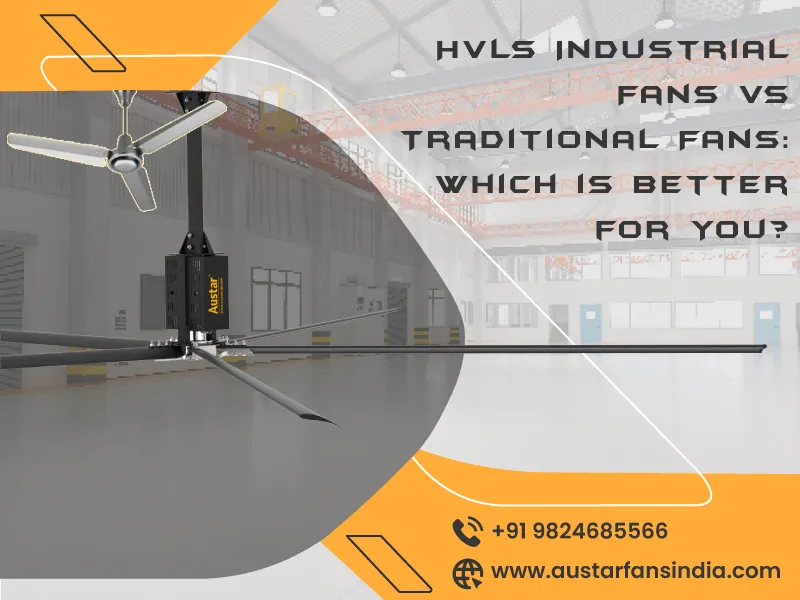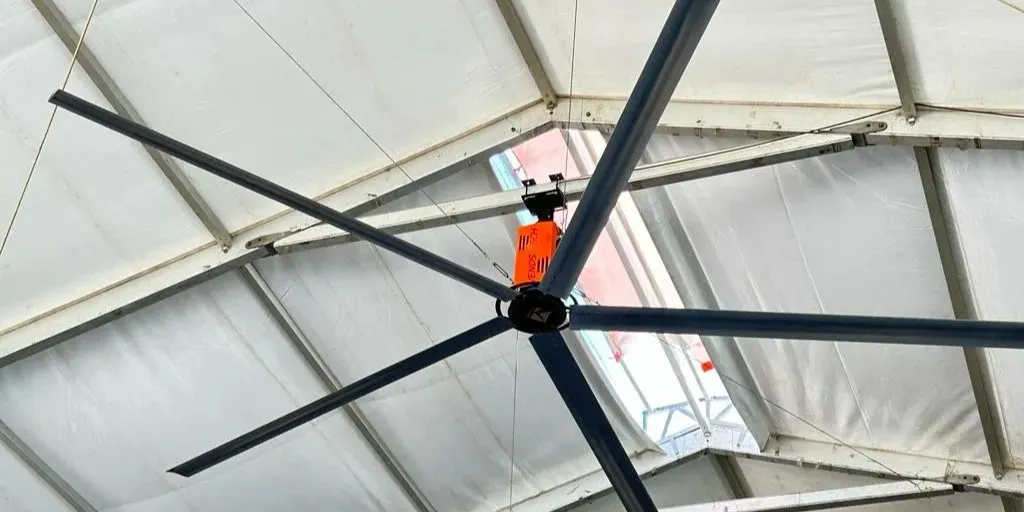
In industrial environments, proper airflow is essential for employee comfort and efficiency. When choosing ventilation solutions for large spaces, two primary options are often considered: HVLS (High Volume, Low Speed) industrial fans and traditional fans. HVLS fans are designed to move large amounts of air efficiently at low speeds, ensuring even airflow across expansive areas, making them ideal for large warehouses, factories, and gyms. They are energy-efficient, quieter, and provide better temperature control. On the other hand, traditional fans are smaller, less expensive, and easier to install, but offer limited coverage and higher energy consumption. They are more suitable for smaller spaces. In this blog, we will compare both types of fans in terms of airflow, energy efficiency, installation, and cost to help you determine which is the best fit for your space and needs.
Overview of HVLS Industrial Fans and Traditional Fans
HVLS Industrial Fans are large, energy-efficient ceiling fans designed to move a high volume of air at low speeds. They are specifically built to circulate air in large spaces, such as warehouses, factories, and gyms, providing enhanced comfort, consistent airflow, and significant energy savings. HVLS fans operate using large blades, allowing them to cover large areas and provide effective air circulation without causing discomfort from high-speed winds.
Traditional Fans, on the other hand, are smaller fans designed for basic air circulation. These fans run at high speeds and often have smaller blades. They are widely used in household and small business environments. While they are more affordable and easier to install, they have limitations in coverage area and energy efficiency compared to HVLS fans.
Importance of Proper Ventilation in Industrial Environments
Proper ventilation in industrial environments is crucial for ensuring the health, comfort, and productivity of employees. In large spaces like warehouses and manufacturing plants, inadequate airflow can result in hot spots, high humidity, and poor air quality. This can cause discomfort for workers and affect their performance. Additionally, equipment and machinery may overheat, leading to potential breakdowns or inefficiencies.
By choosing the right ventilation system, businesses can ensure that their spaces remain comfortable, their employees stay healthy, and energy costs are minimized. With this in mind, let's take a closer look at the advantages and disadvantages of HVLS industrial fans and traditional fans to help you make the best choice for your space.

HVLS Industrial Fans
Advantages
- Enhanced Air Circulation: HVLS fans are designed to move large volumes of air slowly, which allows them to provide more consistent and efficient airflow. This helps to eliminate hot spots and maintain a comfortable environment across the entire space. Whether you're in a warehouse, manufacturing plant, or gym, HVLS fans ensure that every corner of the room receives the airflow it needs.
- Energy Efficiency: One of the primary benefits of HVLS fans is their cooling efficiency. Due to their large size and low-speed operation, they use significantly less energy than traditional fans or air conditioning units. This reduces overall energy costs and provides long-term savings, especially in large spaces where conventional cooling systems can be costly to run.
- Quieter Operation: HVLS fans produce substantially less noise than ordinary high-speed fans. Its low-speed, high-volume airflow decreases wind noise, which is often associated with other types of fans. This makes them excellent for areas where noise control is critical, such as offices and gyms.
Applications
- Warehouses: In warehouses, HVLS fans provide consistent airflow, keeping the environment cool and comfortable for workers. By reducing the reliance on air conditioning, they also help lower energy costs, making them a cost-effective solution for large spaces.
- Manufacturing Plants: HVLS fans are especially beneficial in manufacturing plants where the temperature can rise quickly due to machinery and high levels of activity. These fans ensure that air circulates efficiently, keeping workers comfortable and minimizing the risk of heat stress.
- Gymnasiums: In large gyms or sports facilities, HVLS fans help maintain a comfortable temperature, reducing humidity and creating a pleasant environment for both athletes and gym-goers. Their large coverage area ensures even airflow throughout the space.
Traditional Fans
Advantages
- Lower Cost: Regular fans are often less expensive to buy and install than HVLS fans. This makes them an affordable option for small spaces or businesses with limited budgets.
- Easy Installation: Installing traditional fans is a relatively simple process. These fans are lightweight and do not require extensive installation efforts, making them ideal for smaller spaces or temporary solutions.
- Versatility: Traditional fans are versatile and can be moved from room to room, providing flexibility in use. Whether you need them for a home office, retail store, or other small space, traditional fans are easy to relocate.
Limitations
- Limited Coverage Area: Traditional fans were not meant to cover wide areas. Their smaller size and high-speed operation make them ineffective in large industrial environments, where coverage and consistent airflow are crucial.
- Higher Energy Consumption: Traditional fans consume more energy as they require faster speeds to circulate air. In large spaces, they must run continuously to maintain comfort, resulting in higher energy bills compared to more efficient HVLS fans.
- Noisier Operation: Traditional fans are typically noisier than HVLS fans due to their high-speed operation. The noise produced can be disruptive in work environments, especially in places where quiet operation is essential.
Comparison
Airflow and Coverage
- HVLS Fans: Excellent at producing large-scale, uniform airflow, effectively covering enormous areas like warehouses, factories, and other industrial locations.
- Traditional Fans: Suitable for smaller areas but struggle with large spaces, often creating hot spots and uneven airflow.
Energy Efficiency
- HVLS Fans: Extremely energy-efficient, using minimal power while delivering maximum airflow.
- Traditional Fans: Higher energy consumption due to faster speeds needed, especially in large spaces over extended periods.
Installation and Maintenance
- Traditional Fans: Quick and easy installation with minimal effort required.
- HVLS Fans: Professional installation needed with regular maintenance, but offers significant long-term benefits in energy savings and durability.
Cost
- Traditional Fans: Lower upfront cost but higher operational expenses over time due to energy consumption.
- HVLS Fans: Higher initial investment but better long-term value through energy savings and improved comfort.
Which is Better for You?
Factors to Consider
- Size of the Space: If you're working in a small or medium-sized space, traditional fans may suffice. However, for larger spaces like warehouses or manufacturing plants, HVLS fans are the better choice due to their ability to circulate air more effectively across a wider area.
- Purpose of Ventilation: If your primary goal is to provide basic air circulation, traditional fans will work well. But for spaces that require consistent airflow and temperature control, HVLS fans are the more suitable option.
- Budget Constraints: Traditional fans are more affordable and may be the best option for businesses on a tight budget. However, if you're willing to invest in long-term energy savings and better comfort, HVLS fans provide superior value.
Decision-Making Process
To make an informed decision, evaluate the size of your space, your cooling needs, and your budget. If you need more efficient and consistent airflow, HVLS fans are worth the investment. For temporary or small-scale solutions, traditional fans may be adequate.
Consultation with Experts
It's always a good idea to consult with ventilation experts or HVAC professionals who can assess your space and recommend the best solution. They can guide you in selecting the right fan type based on your specific needs.
Who is the Leading HVLS Fan Manufacturer in India?
Austar Technologies is the leading HVLS Industrial Fans Manufacturer in India, known for its expertise in producing high-quality, energy-efficient solutions for large spaces. With years of experience, we offer a wide range of HVLS fans that ensure optimal airflow, comfort, and temperature regulation in industrial environments. As the best HVLS industrial ceiling fans manufacturer in India, we are committed to delivering durable, reliable products that meet the unique needs of businesses across various industries. Our HVLS fans are designed to provide consistent, quiet airflow, improving employee comfort while reducing energy costs. Austar Technologies focus on performance, innovation, and customer satisfaction has earned them numerous industry accolades, making them a trusted choice for businesses looking to enhance ventilation. Whether it's a warehouse, factory, or gym, we offer timely delivery and excellent products, making us a top HVLS Industrial Fans Manufacturer for businesses seeking effective and long-lasting ventilation solutions.
Conclusion
When choosing between HVLS industrial fans and traditional fans, it's essential to evaluate factors such as space size, ventilation needs, and budget. While traditional fans are cost-effective and easy to install, HVLS fans offer superior airflow, energy efficiency, and comfort in large industrial spaces. Regardless of what you choose, appropriate ventilation is critical to creating a pleasant and productive atmosphere. If you're thinking about using HVLS fans, contact with professionals to find the best choice for your environment.
For more information on HVLS fans or to get a quote, contact Austar Technologies at +91 9824685566 or email us at online@austarfansindia.com.
